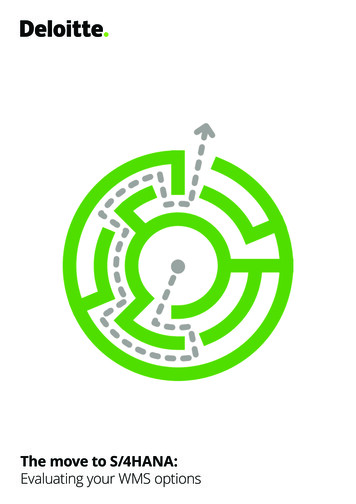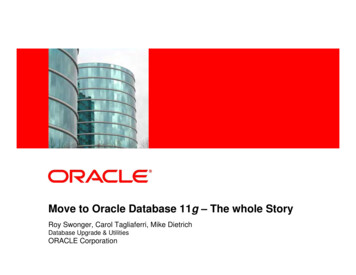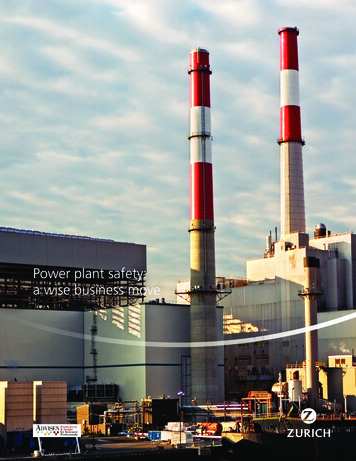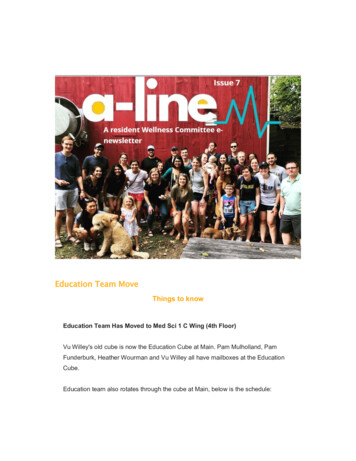
Transcription
The move to S/4HANA:Evaluating your WMS options
The move to S/4HANA Evaluating your WMS optionsThe move to S/4HANA: Reviewing your WMS optionsThis article provides guidance, best practices and various approaches for customers thinking about moving from an ECC basedenvironment towards an S/4HANA suite, more specifically the things to consider when using the warehouse management system.In this point-of-view, we will elaborate on the key elements for transitioning from SAP’s built in WMS solution to SAP ExtendedWarehouse Management (EWM), the principles of the compatibility pack and several scenario’s possible in this transition.SAP EWM – From niche to common best of breedSo what is EWM and why are we mentioning it in the light of an ECC to S/4HANA migration?Workload simulation &real time workmonitoring Transparency,accuracy of work planningIntegrations possibilitiesend-to-endIntegration with other SAP modulesall-in one stackLabor managementNo separate license, completion timemanagement, better work schedulingQuality InspectionTracks quality process by storingdecisions in system including automaticfollow-up actionsWaving & optimizationGrouping tasks, increasedproductivityMFS / WCS includedAllowing to directly control conveyers,AS/RS, EWMSlottingOptimizes storage layout, spaceutilization, ensure right product at theright placeYard ManagementTrack better movement inside the yard,to the door, checkpoint process, etc.Support complex process flowsAdditional steps of in- and outboundflow covered (e.g. deconsolidation,packing, etc.)Value-added servicesSupport processes as kit-to-stock,kit-to-order, customized VAS, etc.Around 2006 SAP introduced Extended Warehouse Management.A new system philosophy led to the development of EWM on acompletely newly build foundation. In the very first release, thecompletely new system basis and document structure allowedto provide not only the known processes but also new ones. SAPEWM incorporates years of knowledge and experience built withSAP WM and combines it with even more powerful functionalitiessuch as extensive Task and Resource Management (TRM),Handling Unit management (HUM), Material Flow Systems(MFS)and Labor Management. Moreover, it integrates broader supplychain functions such as Yard Management and TransportationManagement. This results in a specialized WMS that has nativecapabilities to deal with a wide range of warehouse sizes and theprocess complexities of a modern warehouse.Since the inception of EWM, both products (WM and EWM)02have existed side-by-side without one replacing the other. WhileSAP WM was the WMS core part of the ECC Suite, EWM wasperceived as a specialized product tailored towards higher volumewarehouses requiring more advanced processes – a perceptionthat was also fed by the more complex decentral architecturerequiring EWM to run independently and interfacing with the ECCbackend system.With the introduction of S/4HANA, SAP has decided to abandonthe old WM core and replace it with the more modern EWM core.EWM is the new WMS as part of the S/4HANA suite.This means that moving from an ECC environment towards anS/4HANA environment also means migrating – independently ofthe ERP migration – from WM to EWM as WMS solution.
The move to S/4HANA Evaluating your WMS options03
The move to S/4HANA Evaluating your WMS optionsEWM is the new WMSas part of the S/4HANASuite. Moving toS/4HANA will thereforeintroduce the need foran independent WMSmigration to EWM.04
The move to S/4HANA Evaluating your WMS optionsEnvisioning S4-EWM as yournew WMS core – First thoughtsMigrating towards S/4HANA foractive LE-WM users: Scenario’sMigration sequenceIntroducing the Compatibility Pack (CP) as temporarylanding zoneMigrating your SAP WMS together with your ERP is not a necessity.SAP commits to support the customers using SAP WM until2025, which gives customers time to foresee in a roadmap andadequately analyze their transition path.Technically SAP foresees a ‘compatibility pack’ to enable customersto run a WM environment as part of S/4HANA temporarily. Outof this ‘landing zone’ on the S/4HANA environment, the WMSmigration can then be initiated at a later stage.LicensingThe introduction of a new WMS core does not mean your licensecost will go up by default.Even though SAP is clear on abandoning WM and replacing it withEWM as the future WMS core, the licensing model put in placeallows the use of a basic version of EWM embedded in S/4HANAwithout additional (on top of S/4HANA license) license fee.As already briefly mentioned before, SAP foresees in a LE-WMCompatibility Pack for those customers who plan to move toS/4HANA prior to migrating from LE-WM to EWM.This Compatibility Pack enables customers to move their currentclassic WM component to an S/4HANA compatible version duringthe S/4HANA upgrade, effectively allowing them to maintain full useof their existing WM setup.Even though these Compatibility Packs provide a convenient wayof encapsulating your classic setup, allowing it to run on the newS/4HANA platform - which might be appealing and sufficient forsome customers - it should be clear these are only intended to beused temporarily to facilitate the transition towards S/4HANA. Itshould not be considered as a valid WMS migration solution.System architectureS/4HANA comes with an embedded EWM version, which runswithin S/4HANA very similar to WM as part of the ECC Suite. Theintroduction of EWM as core WMS therefore does not have tomean a complete review of your system landscape or preparing fora 2-tier architecture including new interfaces.Migration benefitEven though the 2025 deadline SAP has put in place might be theinitial incentive to start investigating a possible migration approach,it needs to be clear that it need not just be a technical migration.The embedded EWM WMS using the basic license alreadyincorporates more functionality than what standard WM couldoffer. Some of the differentiating functionalities are: a moreextensive resource management, native process modelling bymeans of storage processes (vs the transactional approach of WM)and the elaborate configurable options to construct work packagesout of warehouse task via warehouse order creation rules.05
The move to S/4HANA Evaluating your WMS optionsThe use of Compatibility Packs therefore comes with some restrictionsFunctionalityTimeCostSAP has clearly detailed outthe type of classic functionalityfor which there is an S/4HANAcompatible version (CP). Noadditional functionality orextension of existing functionalityis expected in the light of newS/4HANA releases.The use of CPs is restricted to2025 after which SAP will revoketheir usage rights and mighteven disable them completely.Their continued use in a nonvalidated/unsupported way is notguaranteed.CPs only help run classicfunctionality on the S/4HANAplatform. They therefore stillrequire the classic functionality tohave an active license next to theS/4HANA license as long as thefunctionality is in use via the CP.Note however that CPs only applyfor classic functionality running outof the S/4HANA platform. Classicsolutions running in a side-carsetup do not require a CP and cancontinue to be used in conjunctionwith S/4HANA.WMS Solutions and their migration optionsThe most common ECC-based WM/EWM deployment scenarios and the key considerations for migrating towards an S/4HANAenvironment are listed below.Lean WMLeanfunctionalities,but no Lean EWMsolution06
The move to S/4HANA Evaluating your WMS optionsLean WM today is part of the LE-WM component. This means that LE-WM Compatibility Pack can run it with S/4HANA.However, there is no solution today for those customers who want to continue to use Lean WM functionalities under S/4HANAbeyond the CP lifespan. SAP made clear that they are not planning to foresee a lean version of EWM, but state that they mightplan to provide new lean functionality as part of the EWM core to replace Lean WM in future releases of S/4HANA.LE-WMCustomers using LE-WM today have a number of options to transition to an S/4HANA based solution. The one mentionedthroughout this document is to migrate the ERP to S/4HANA first and use the compatibility pack for LE-WM on S/4HANA as alanding point. At a later phase, once the S/4HANA environment is stable and business had time to optimize the mapping of theexisting business processes to SAP EWM processes, initiate the migration from WM to EWM.For executing WM to EWM migration, SAP provides tools to facilitate the process. These tools extract and convert some basiccustomizing settings (e.g. warehouse structure, movement types etc.) from the WM to the EWM environment.As an alternative to migrating from LE-WM to an embedded EWM on S/4HANA, customers could also opt to start by settingup a decentral EWM system – for which the same WM to EWM migration tools can be leveraged. Initially this decentral EWMsystem would be connected to their existing ERP. After the ERP to S/4HANA migration is done, the decentral EWM systemwould be connected to the new S/4HANA environment. There might be several reasons for considering this approach: Your current WM environment is on the same system as the other ERP components causing performance issues. Thismakes the migration project an ideal time to move the warehousing component to a decentral system safeguarding it fromany impact coming from other ERP components. You have taken a strategic decision to allow the ERP upgrade path to be independent – and without impact – of the WMSupgrade path. You want to sequence the WMS migration before the ERP migration. For customer with a large amount of warehouses, beingable to start with the WMS migration as early as possible might be a must in order to have all warehouses migrated prior tothe 2025 deadline SAP is putting on the use of LE-WM.07
The move to S/4HANA Evaluating your WMS optionsWM DecentralCustomers using WM decentral, can continue to do so as long asthe ECC platform hosting the decentral WM component is within itsmaintenance support time window (currently 2025 for the latest ECCrelease)As the ERP LE-IDW component which is responsible for the integrationwith decentral WM instances is also available in S/4HANA, connectingtheir decentral WM instance to S/4HANA is not a problem.Due to the 2-tier system landscape, those customers have full flexibilityin how they want to sequence the WMS migration to the ERP migration– they can start with upgrading their ECC instance to S/4HANA beforeevaluating their WMS upgrade path, or do the opposite and migratetheir decentral WM to a standalone EWM instance first.Even thinking about leaving the 2-tier landscape and pulling someof the decentral EWM warehouses back into S/4HANA (leveragingthe embedded EWM) might be considered. SAP had always statedthey would not foresee a migration path between different versionsof EWM, but now they seem to be reconsidering this approachand will potentially allow to migrate in between the embedded andthe standalone version of EWM. (SAP plans to introduce S/4HANAEmbedded EWM as the target architecture for decentral EWMinstances in Q2 2019. In this light migration tools will be available tomigrate from a decentral standalone EWM to a decentral S/4HANAEmbedded EWM scenario)08
The move to S/4HANA Evaluating your WMS optionsEWM on top of ECCDe-installationas a prerequisiteto the ECCconversionCustomers using EWM as an add-on to SAP ECC need to realize that the de-installation of EWM is a necessity to perform theconversion of their ECC system towards S/4HANA.In this scenario, it might therefore be opportune to setup a decentral EWM system and migrate the current EWM set-upmanually. Afterwards the EWM add-on could be de-installed and the ERP system converted to S/4HANA. The end state wouldthen be a decentral EWM system linked to an S/4HANA backend ERP. In case SAP would actually provide a migration path fromdecentral EWM to embedded EWM (as mentioned above), one could migrate back to an EWM solution as part of S/4HANA,thus eliminating the decentral system setup again.EWM decentral09
The move to S/4HANA Evaluating your WMS optionsCustomers already having a 2-tier system landscape in which EWM is setup as standalone, should be able to upgrade toS/4HANA without any concern. No pre-upgrade activities are expected on the EWM system assuming it has a release as ofEWM 7.0 SP13 for an SCM based system or an EWM 9.0 non-SCM based.ConclusionWith SAP S/4HANA, SAP brings a new world of possibilities for logistics as it introduces SAP EWM as the S4 Suite’s core WMS.Not only did SAP replace the core WMS, but they also plan to phase out SAP WM completely by the end of the mainstreamsupport window in 2025. This means that especially companies currently relying on SAP WM as their main WMS are facingadditional challenges. They need to rethink their deployment strategy to make the most out of the S/4HANA potential in themid-term while starting up a migration roadmap of their existing/new facilities in short-term. This paper therefore aims toposition the SAP WM transformation options for ECC customers moving towards S/4HANA.How can Deloitte help?With its technical expertise, business process knowledge and global network, Deloitte is capable of providing solutions for allthe challenges you face with rapidly changing technology.More specifically, our Belgian-based EMEA Center of Excellence around EWM has profound experience and following specificservices that can help you on your transformation journey. WM to EWM migration services – From helping you with the scope and complexity assessment of your SAP WM basedwarehouses in order to foresee in a complete roadmap, to facilitating the execution of the actual migration. SMART Solution – An EWM preconfigured solution specifically targeted towards the SME market. The solution provides anefficient and low-threshold way of introducing an EWM environment in which SAP WM users can easily identify the processesan
With the introduction of S/4HANA, SAP has decided to abandon the old WM core and replace it with the more modern EWM core. EWM is the new WMS as part of the S/4HANA suite. This means that moving from an ECC environment towards an S/4HANA environment also means migrating – independently of the ERP migration – from WM to EWM as WMS solution. EWM











